Illuminate Your Atmosphere with Crystal Soy Candles and Home Fragrance
Illuminate Your Atmosphere with Crystal Soy Candles and Home Fragrance
Blog Article
From Wick to Wax: Comprehending the Chemistry Behind Soy Wax Candles and Their Environmental Impact
As we brighten our rooms with the cozy glow of candle lights, there lies a world of elaborate chemistry behind the apparently simple act of lighting a soy wax candle. Join us as we decipher the scientific complexities behind soy wax candle lights and discover their ramifications on our atmosphere.
Soy Wax Vs. Paraffin Wax
When comparing soy wax and paraffin wax for candle making, it is important to understand the distinct qualities and advantages of each material. Soy wax is a natural, renewable energy stemmed from soybean oil, making it eco-friendly and biodegradable - soy wax candles. On the other hand, paraffin wax is a by-product of petroleum refining, which elevates issues regarding its environmental effect and sustainability
Soy wax candle lights shed cleaner and produce less residue compared to paraffin wax candles, making them a healthier option for indoor air quality. In addition, soy wax has a lower melting factor, enabling a longer-lasting candle that disperses scent better. Paraffin wax, on the other hand, tends to melt faster and much less easily, possibly releasing damaging chemicals into the air.
From a sustainability point of view, soy wax is preferred for its biodegradability and renewable sourcing, aligning with the expanding customer choice for environmentally conscious items. While paraffin wax has been a typical choice in candle light making as a result of its cost and simplicity of use, the change in the direction of environmentally friendly alternatives like soy wax is gaining energy in the industry.
Chemical Composition of Soy Wax

Burning Refine in Soy Candles
The chemical composition of soy wax directly affects the combustion process in soy candles, influencing variables such as melt time, fragrance launch, and ecological effect. When a soy candle light is lit, the heat from the fire thaws the wax near the wick. This liquid wax is after that attracted up the wick because of capillary action. As the fluid wax gets to the fire, it undergoes and evaporates combustion. The combustion process entails the vaporized hydrocarbons in the wax reacting with oxygen in the air to generate warmth, light, water vapor, and carbon dioxide.
The burning efficiency of soy candle lights is affected by the purity of the soy wax and the high quality of the wick. Additionally, soy wax candles have a lower ecological effect contrasted to paraffin candle lights due to their renewable and naturally degradable nature.

Ecological Advantages of Soy Wax

Considered a sustainable soy wax candles choice to traditional paraffin wax, soy wax offers notable environmental benefits that make it a prominent option among eco-conscious customers. One substantial benefit of soy wax is its renewable sourcing. Soy wax is stemmed from soybean oil, which is predominantly grown in the USA. The farming of soybeans assists support regional farmers and discover this info here lowers the dependence on non-renewable nonrenewable fuel sources made use of in paraffin wax manufacturing. Furthermore, soy wax is naturally degradable, indicating it damages down naturally without launching harmful toxic substances right into the environment. This particular makes soy wax candle lights a more eco-friendly choice compared to paraffin wax candle lights, which are made from petroleum, a non-renewable resource. Soy wax burns cleaner and produces much less soot than paraffin wax, adding to far better interior air quality and lowering the requirement for cleansing and upkeep. Generally, the ecological benefits of soy wax straighten with the growing need for sustainable and environment-friendly products out there.
Recycling and Disposal Considerations
Reusing and proper disposal of soy wax candles play an important function in maintaining ecological sustainability and reducing waste in households and communities. When it comes to recycling soy wax candles, the first action is to make certain that the candle light has burned entirely.

In terms of disposal, if recycling is not an option, soy wax candles are naturally degradable and can be securely disposed of in many home waste systems. However, it is always recommended to examine with regional recycling centers or waste administration services for particular guidelines on candle light disposal to guarantee correct handling and environmental management.
Final Thought
To conclude, the chemistry behind soy wax candle lights reveals their environmental benefits over paraffin wax candle lights. Soy wax, obtained from soybean oil, burns cleaner and produces less residue when compared to paraffin wax. The burning process in soy candle lights is much more efficient, causing a longer and extra even burn. Furthermore, soy wax is renewable and naturally degradable, making it an extra sustainable option for candle production. Reusing and proper disposal of soy wax candle lights even more add to their environmental impact.
When comparing soy wax and paraffin wax for candle production, it is necessary to understand the distinct attributes and advantages of each material (candles).Soy wax candles shed cleaner and send out less residue contrasted to paraffin wax candle lights, making them a healthier option for interior air high quality.Taken into consideration a lasting alternative to conventional paraffin wax, soy wax uses notable environmental advantages that make it a prominent option amongst eco-conscious customers. Soy wax burns cleaner and generates much less residue than paraffin wax, adding to far better indoor air high quality and minimizing the demand for cleansing and upkeep.In verdict, the chemistry behind soy wax candles reveals their environmental advantages over paraffin wax candles
Report this page